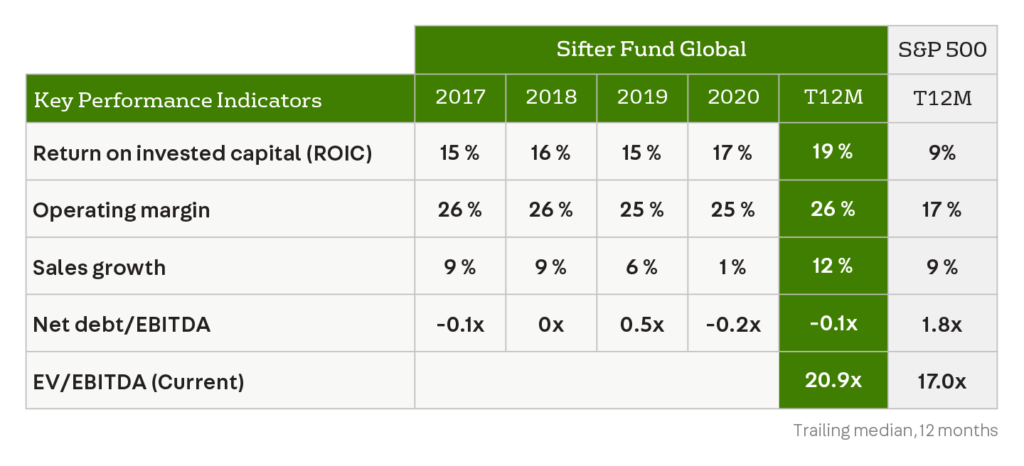Sooner or later, the stock market will fall. Valuations then disappear quickly, especially for stocks whose business is not on sound footing. Therefore, stock selection for a bear market is made during a bull market. What kind of companies should be in the portfolio if one wants to be invested in stocks during the market downturns?
Quality companies have performed well in downturns
Historically, the share prices of quality companies have held their ground during periods of stock market decline. Indeed, the excess returns of a Quality-Focused investment strategy are usually made during weak economic times.
There are several rational reasons for the over performance of quality companies in a declining market. Investing in quality companies could be described, for example, as “buying excellent companies at a reasonable price.” Several studies have shown that quality stocks have outperformed the market in the long run with lower than average volatility.
Steadily growing companies, high ratio of recurring revenue, customer-critical products and good profitability, will be further strengthened during a downturn.
Good profitability is one of the hallmarks of a quality company.
How to analyze a company’s short- and long-term financial profitability? Let’s look at this using the investment criteria for quality companies in the Sifter Fund.
What does a quality portfolio look like in terms of KPIs?
The table compares the key business indicators (KPIs) of the Sifter Fund and the S&P 500 index companies. The Sifter fund companies’ Return on Invested Capital (ROIC), operating profit, revenue growth and net debt are better than those of the S&P 500 companies.

Numerical selection criteria tell the history of the company
The identification of a quality company is first based on solid numerical data, which make it clear that the company has already demonstrated superior financial ability historically. Key numerical selection criteria include:
1. Sales and operating profit have grown steadily and are predictable
Investing is very much about estimating a company’s future growth and profits. Therefore, predictability of growing sales is important for a quality investor. Steady revenue reflects customers’ preferences and loyalty.
An increasing operating profit reflects a company’s efficiency and ability to generate money. The predictability of positive cash flows, in turn, brings peace of mind to the shareholder.
2. Higher gross and net margins than competitors
High gross margins indicate that the company’s products and services have pricing power i.e. customers are willing to pay a premium. A high gross margin gives the company room to maneuver in price competition and the ability to pass on inflationary pressures to product prices.
Correspondingly, high net margins indicate a company’s efficiency in manufacturing and selling products, creating more value for the owners and investors.
3. High Return on invested Capital (ROIC)
Among other things, a high ROIC indicates that the company’s management is consistently finding good investment targets to develop and grow its own business. A high ROIC generally promises future profits as well.
We like companies that invest in business growth rather than distributing profits as dividends to shareholders.
4. A solid balance sheet, preferably a net debt-free company
We like companies that are able to grow their business without large debts. A strong balance sheet is especially important when shocks occur in the market that may make capital less available and more expensive.
In addition, we want our companies’ balance sheets to be clean, meaning they do not include large items, such as goodwill.
Qualitative selection criteria bring security and future growth
Numerical factors are just a scratch of the surface of the analysis. The main research focus is always on the qualitative characteristics of a company, which reveal whether the future of the company is as good or even better than its history.
Qualitative factors also allow for positive future stock price development.
1. The earnings model is competitive
The earnings model is the engine of a company with which the company makes money. When the earnings model is difficult to copy and preferably scalable, the company is able to protect itself from competition and the growth opportunities are significant.
Example from Sifter portfolio: How does Costco make money?
2. The market entry threshold is high
Market growth always attracts competitors. Therefore, a high entry threshold is an important feature for quality companies as it minimizes price competition. Typical barriers to entry may include regulatory barriers, patents, geography, technological leadership, and sometimes a small niche market.
3. Products and services are critical to customers
During a recession, businesses and consumers are cutting costs. A product or service of a quality company is typically critical to the customer and therefore their use is not lightly discontinued. As a result, the predictability of a quality company’s profits remains high even during downturns.
4. The product represents only a small part of the customer’s total costs
The price of critical products and services is not so big issue for the customer when they represent only a fraction of the customer’s total costs. This, too, protects quality companies when there are otherwise difficult times in the economy.
5. A significant part of the revenue is recurring
A quality company must have predictable revenue. Often it is the recurring revenue eg. service contracts that represent this part of the business. Another way to assess the predictability of revenue is to examine the loyalty and purchasing behavior of the company’s customers during different economic times.
Example from Sifter portfolio: Verisign is a strong quality company with good pricing power and a predictable earnings model.
6. The company’s products have pricing power
Pricing power indicates a strong market position. In addition, pricing power allows the company to change pricing as competition intensifies. The most critical products also have price flexibility. Even if the price of the product goes up, it will still be purchased. This protects the company’s ability to make money during periods of high inflation, when raw material prices and wages rise.
7. The industry or niche market is growing
The growth in the downstream market explains more than 60% of the company’s revenue growth. In a saturated market, companies are forced to compete on price and try to capture market share from competitors, often at the high cost. We prefer companies whose business is focused, and they are operating in a growing industry or are number one in a small but growing niche.
Stock selections are more important now than ever
In a booming market, almost all stocks are in vogue. A market correction or downturn in the economy will usually reveal whose foundations are solid. Therefore, The Sifter Fund has three principles in its investment strategy:
- We do not believe in market timing. Guesswork also leads to new problems such as the problem of reinvesting profits.
- We want to invest in high quality companies and own them in all market situations. We believe that strong quality companies will succeed and even strengthen during downturns.
- We constantly monitor the financial capacity and competitive advantages of our companies. We divest companies when we find a better company to replace it or the company’s ability to make money crumbles.
We are ready to weather a downturn in the stock market, knowing that our companies will endure and eventually rise even stronger into the new upswing.
For many, the idea of such a peaceful investment may be unfamiliar. It is not a question of investing, but of long-term ownership of quality companies.
Interested in long-term quality investing? Download our 20-page guide: Long-term quality investing. Our guide explains how time and high-quality companies work in an investor’s favor.
Santeri Korpinen
CEO, Sifter Capital


